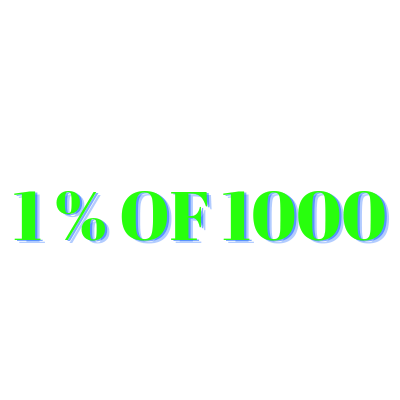What is 1% of 1000In our everyday lives, percentages are a common concept used to represent parts of a whole. From calculating discounts during shopping to understanding interest rates on loans, percentages play a crucial role. In this article, we will explore the meaning of percentages and specifically answer the question: What is 1% of 1000? 
To understand percentages better, let's start with the basics. The term "percent" refers to per hundred, denoted by the symbol "%." It allows us to express a fraction of a whole based on a scale of 100. Percentages make it easier to compare values and understand proportions in various contexts. How to Find PercentageOne of the simplest methods for calculating a percentage involves using the following formula: Percentage = (Part / Whole) x 100. Here, the term "Part" represents the specific value or quantity you wish to determine the percentage of, while the term "Whole" represents the entire set or total. By multiplying the resulting ratio by 100, you convert it into a percentage. How to Calculate a Number's PercentageEmploy the following strategy to calculate the percentage of a given number: Step 1: The number should be multiplied by the desired percentage in decimal form. Step 2: The result will show how much of the number is represented by a percentage. To determine 25% of 80, for instance: 80 times 0.25 equals 20 in terms of percentage. 1% of 1000When we refer to "1% of 1000," we are essentially seeking to determine the value that represents 1 percent of 1000. Mathematically speaking, finding 1% of a number entails dividing the number by 100 and then multiplying the resulting quotient by 1. This calculation enables us to ascertain the fraction or proportion of the value that corresponds to 1 percent. Let's calculate 1% of 1000 using this method: Step 1: Divide 1000 by 100. 1000 ÷ 100 = 10 Step 2: Multiply the result by 1. 10 × 1 = 10 Hence, 1% of 1000 is equal to 10. Therefore, if we take 1% of 1000, the value will be 10. To put it in context, consider an example. Suppose you have 1000 dollars and want to calculate 1% of that amount. Applying the steps outlined above, we find that 1% of 1000 dollars is equal to 10 dollars. So, if you were to calculate 1% of any value, say 1000, you would arrive at the result of 10. Application of PercentagesPercentages are utilized extensively across various disciplines and find numerous practical applications. Here are several common examples highlighting the wide range of contexts where percentages are employed effectively:
Conclusion:Understanding percentages is essential in many aspects of our lives. When we ask, "What is 1% of 1000?" we are seeking to find 1 percent of the value 1000. By dividing 1000 by 100 and multiplying the result by 1, we determine that 1% of 1000 is equal to 10. Percentages allow us to express fractions of a whole based on a scale of 100, facilitating comparisons and analyses in various fields. By grasping the concept of percentages, we can navigate the numerical landscape with greater confidence and accuracy.
Next TopicWhat Is 1 Mod 4
|
 For Videos Join Our Youtube Channel: Join Now
For Videos Join Our Youtube Channel: Join Now
Feedback
- Send your Feedback to [email protected]
Help Others, Please Share










